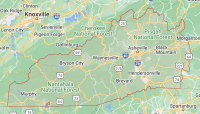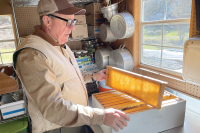A gifted writer, a great naturalist
Those of you who enjoy reading books about the Smokies should make an effort to locate a copy of Hidden Valley of the Smokies: With a Naturalist in the Great Smoky Mountains (Dodd, Mead & Company, 1971) by Ross E. Hutchins. It is one of more informative books yet written about the natural history of this region.
Hutchins (1912-1983) possessed a trained scientist’s mindset and powers of observation. Unlike many scientific writers, his long experience as a writer for popular magazines and books enabled him to describe the somewhat technical processes that interested him in an engaging manner.
Hutchins was born in Alder Gulch, a gold mining camp in Montana. He grew up on a cattle ranch in the high Rockies near Yellowstone National Park, never descending below 5,000 feet elevation until he was over 20 years of age. In his autobiography, Trails to Nature’s Mysteries: The Life of a Working Naturalist (1977), he reflected: “Having grown up in a mountainous area, it was perhaps inevitable that I should become attracted by the Great Smoky Mountains, the nearest one to my adopted home in the South.”
The “adopted home” was Starkville, Miss., where since the 1930s Hutchins had been professor of entomology and zoology at Mississippi State University as well as longtime director of the State Plant Board of Mississippi. He was the author of more than 40 books — all illustrated by his photographs, which were exceptional in regard to magnification of minute details.
In addition to books about seeds, dragonflies and damselflies, grasshoppers, galls and gall insects, ants and similar subjects, he wrote three excellent general accounts of natural history: Island of Adventure: A Naturalist Explores a Gulf Coast Wilderness (1968); Hidden Valley of the Smokies; and the 1977 autobiography.
It was perhaps in the mid-1960s, but exactly when Hutchins and his wife established seasonal residence at Elkmont on the Tennessee side of the national park is unclear. In Hidden Valley of the Smokies, he advises the reader: “I call it Hidden Valley with good reason; to me, that name is most descriptive of its nature. Places I love I usually designate by my own special names ... and thus named, a place becomes ‘mine.’”
Related Items
While exploring “Hidden Valley” he considers topics such as seed dispersal mechanisms, the pollination tactics of various plants, skunks and “chemical warfare,” why many trees have twisted grains, medicinal and deadly plants, and more.
An entire chapter titled “Leaves in the Sun” is devoted to leaf shapes, leaf “drip tips,” leaf flight patterns, leaf volume and the special “voice” each tree possesses — it is a veritable tour de force of leaf lore. After reading Hutchins on leaves, you’ll never look at a leaf the same way again. Here are some excerpts:
“Leaves, seemingly in infinite number, festoon the trees and herbaceous plants of the valley, and one afternoon I wondered how many there actually were. My first thought was that it would be impossible to make even a wild guess. Yet when I considered the matter, it occurred to me that by calculating the number of leaves per square foot — not an impossible task — I might arrive at some reasonable figure ... In any case, I decided to attempt an estimate of the number of leaves — on both trees and herbaceous plants — on an acre of ground in Hidden Valley. I imagined a column, one square foot in area, reaching upward from the earth to the tops of the trees and estimated the number of leaves within it. A month later, after the leaves had fallen from the trees, I made several counts of dead leaves on the ground and obtained an average. The conclusion was that on each square foot there had been an average of about two hundred living leaves. The conifers — hemlocks and pines — ignored, since I could not decide how to classify their needles ... From the above figure I determined that on each acre of ground there had been 8,712,000 leaves. Carrying my calculations even farther, assuming there to be about six square miles in the valley, I found that there had been about 33,454,080,000 leaves ...
“Abundant as are the leaves of these forests, each one has its own individual form and structure; no two, even on the same tree or plant, are exactly alike .... Why, you may ask, are there such variations in leaf shapes? The answer is not at all simple. Some leaves have pointed, downwardly directed tips that facilitate the runoff of rain water, eliminating the water before it can injure the leaves by inducing the growth of fungi or by focusing the rays of sunlight upon the leaves’ delicate tissues. In the forest there are many examples of leaves with drip tips. On the other hand, many leaves are ovate in form, having no adaptations for the rapid elimination of water ...
“The subject of drip tips is an illusive one and I hesitate to generalize too much. Drip tips must have value; otherwise not so many leaves would be equipped with such a mechanism. I recall that the buckskin jacket of the American Indians and early trappers were almost always fringed. These fringes, contrary to the usual assumption, were not merely decorative; in effect they were drip tips, aiding water to drip off quickly, without soaking the remainder of the clothing ....
“Seated here on a boulder this mid-October afternoon, I watch the falling leaves sailing down like gayly colored confetti and marvel at the miraculous autumn season, and the indiscriminate array of colors around me ... Usually I can identify a leaf by the way it falls, although the shape in which it dries before falling from the tree also influences the path it follows. In general, maple trees spiral downward, following a helical path; oak leaves zigzag in their descent, swinging from side to side in hurried movements; the leaves of the sycamores settle gracefully down, exhibiting but little lateral movement and do not spin. (Sycamore leaves remind me of small, inverted parachutes.) Willow leaves, slender and lanceolate in form, have a most characteristic manner of all; they spin rapidly on horizontal axes. I am sure I could classify each kind of tree leaf by the way it falls. Each one by its shape is governed by the complexities of its aerodynamics.
“Against the background sounds of the roaring stream in Hidden Valley is the music of the forest, the multitudinous voices of the trees as the wind blow through them. There is the soft but audible breath of the breeze in the pines and the hemlocks, and the sonorous tones of the broad-leafed trees. Never is there complete silence in the valley, and often, while alone there, I imagine that each tree has its own special ‘voice.’”
George Ellison wrote the biographical introductions for the reissues of two Appalachian classics: Horace Kephart’s Our Southern Highlanders and James Mooney’s History, Myths, and Sacred Formulas of the Cherokees. In June 2005, a selection of his Back Then columns was published by The History Press in Charleston as Mountain Passages: Natural and Cultural History of Western North Carolina and the Great Smoky Mountains. Readers can contact him at P.O. Box 1262, Bryson City, N.C., 28713, or at This email address is being protected from spambots. You need JavaScript enabled to view it..









